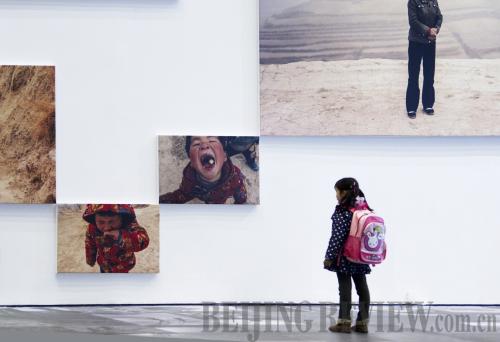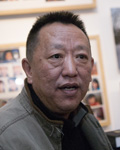|
 |
|
HI, PEERS: A young girl looks at the photos at the Hidden Land exhibition on April 20 (WANG XIANG) |
A village seated deep in the mountains of northwest China's Ningxia Hui Autonomous Region was the center of a photographic whirlwind meant to foster greater intimacy between photographer and subject.
In December 2012, a group of artists from Beijing broke the silence in remote Shangjuanzu Village of Xiji County, once home to 200, with the clicking of shutters, clappers and pens.
The United Nations designated Xiji as an inhospitable region in the 1970s due to its limited water and food resources. Shangjuanzu isn't accessible by roads, and electricity only became available in 2010. There was little hope of a better life for its inhabitants until a relocation program was launched in 2012 to move them to flatlands.
 |
|
BEHIND THE SCENES: Wang Zheng, an initiator of the photographic outing to the remote Shangjuanzu Village, hopes the activity can help participants seek inspiration from the lives of villagers (WANG XIANG) | By the time the visitors from Beijing arrived, half of the houses in Shangjuanzu had been torn down and only 91 people from 22 households were still living there. Wang Zheng, a Xiji-born freelance photographer, initiated the outing to Shangjuanzu in November 2012 along with several friends to shoot photos at the original site of the village.
In pursuit of creativity
Although participating artists involved movie directors, poets, novel writers and even painters, the Shangjuanzu-based visual art program is mainly for photographers, who, according to Wang, are stuck on the question of how to find more photographic possibilities.
With more than 30 years of photography experience, the 51-year-old Wang has judged some photography competitions focusing on rural life. He said most works look similar.
"The pictures are either about happy harvests or the beautiful scenery in rural areas, but only a few show the daily life of the villagers—it is not enough at all," said Wang.
For Chen Xiaobo, photo editor at Xinhua News Agency, it is not just a problem with rural life pictures, but the whole industry.
"We clearly divide the photos into categories such as portraits, landscapes, etc. and teach how to take good pictures in each category," said Chen. "This has confined photographers' creativity to an established format."
 |
|
CAPTURING MOMENTS: Zang Ce advises photographers to rediscover their original feeling or passion for photography (WANG XIANG) |
According to Zang Ce from the China Photographers Association, the reasons why many photographers are unable to take great photos are inadequate equipment, travel money and academic training.
"These factors do matter of course, but these influences get exaggerated," said Zang. He suggests photographers turn back to their original feeling or passion for photography to break down barriers to creativity.
"When I was a fresh photographer, I was curious about everything around me and wanted to display it all with my camera," said Zang. But, he admitted that after learning more skills, this curiosity faded away as he began to focus more on the composition of photographic elements rather than the subjects themselves. "The problem is not being insufficient, but overwrought. What we want to do is help the photographers alleviate burdens instead of teaching them more," he said.
Sharing Zang's idea, Wang had long planned a photographic outing to the countryside to seek inspiration from the everyday lives of villagers. He finally chose Shangjuanzu as the destination.
"It is like a huge performing art and we had no idea what would happen," said Zang.
Full of surprises
The village never had any guests from major cities before and prepared a warm welcome at the gates.
Wang purposely chose December, as it is well after the fall harvest, providing ample time for villagers' participation in the program.
| 